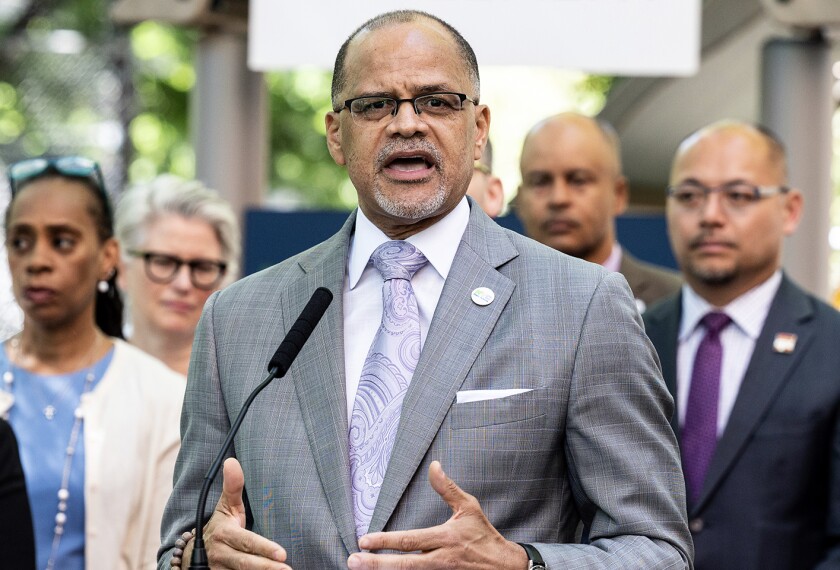An overwhelming majority of educators say the pandemic prompted new and greater use of technology in their classrooms, according to new results of a nationally representative survey conducted by the EdWeek Research Center.
The assumption among many ed-tech proponents is that the influx will help level the K-12 playing field. But not so fast, said four experts consulted by Education Week.
“My hunch is that there’s been ... a narrowing of access gaps,” said Justin Reich, the director of the Teaching Systems Lab at the Massachusetts Institute of Technology. “But we’ve known for 30 years that is not the only disparity in technology.”
To really gauge the impact of new school technology on equity, Reich and other experts said, we must also look at elements like product design, teacher training, and organizational capacity, as well as the potential downsides that come with more technology.
A deeper discussion of each is below.
Justin Reich, Director, Teaching Systems Lab, Massachusetts Institute of Technology

There’s no question that schools of all stripes have much more “stuff” since the start of the pandemic, Reich said.
But greater access to Chromebooks or mobile hotspots doesn’t necessarily lead to greater equity, he cautioned. In fact, a robust body of research suggests more technology actually tends to make longstanding inequities worse. Call it the “digital usage divide.”
“In affluent schools, technology is more likely to be used for creative expression, for complex problem-solving, with more adult mentorship and support,” Reich said. “In [poor] schools, [it’s] more likely to be used for drill-and-practice, and more independently.”
Complicating matters, we have very little visibility into what teachers and students have actually been doing with all the new technology schools bought during the pandemic. If history is a guide, Reich said, the biggest changes have likely been in how schools use administrative tools such as student information systems to help with non-instructional tasks like taking attendance and communicating with parents.
“We have always found in the history of educational technology ... that the first things people change are these logistical, transactional sorts of things,” he said.
Alex Twinomugisha, Senior Education Technology Specialist, World Bank

Similar disparities are evident on a global scale, said Alex Twinomugisha, who tracks technology use in schools in Africa and Asia as part of the World Bank’s global edtech team.
“We see three big divides that lead to inequities,” Twinomugisha said. “Most often, people focus on devices ... and access to connectivity. The second big divide is human capacity. Do teachers have the skills to use [and teach with] the technology?
And the third is the organizational capacity to identify the right technology, to procure it, to deploy it at scale, and to manage and maintain it.”
During the pandemic, poorer countries like Malawi were largely stuck in that first gap. Schools there were forced to rely on low-tech options such as radio and television, and the national Ministry of Education was largely unable to monitor actual student learning outcomes until students returned to physical classrooms.
Elsewhere, though, a World Bank study found that more affluent countries with a longer history of investment in educational technology—and therefore more experience with supporting students and teachers in using ed tech for clear educational purposes—adapted to remote learning better. In Uruguay, for example, online curricular resources and an online teacher-coaching program instituted before the pandemic helped boost a national remote-learning strategy that earned near-universal satisfaction from families and educators alike.
To narrow such divides moving forward, Twinomugisha said, countries just now ramping up their ed-tech investments must learn from the rest of the world, so they can quickly build their human and organizational capacity without long periods of trial-and-error—a similar dynamic to that found within the United States, where the gaps between well- and poorly-resources schools are often vast.
“Rich countries can afford to experiment,” he said. “Poor countries can’t.”
Nidhi Hebbar, Co-Founder, Edtech Equity Project

Equity advocates like Nidhi Hebbar say the ed-tech sector has been slow to confront those deeper divides, too.
“With respect to connectivity, I think that conversation is really shifting,” she said. “But the more meaningful piece around racial equity, with respect to how algorithms are designed and where their [training] data come from, I think until or unless schools start saying, ‘We aren’t going to buy a product that hasn’t been designed with our students in mind,’ I don’t know that companies will have the capacity to prioritize those questions.”
Hebbar highlighted SoapBox Labs, which makes voice-recognition software designed specifically for kids, as an example of the possibilities. In October, the company became the first to be awarded the Prioritizing Racial Equity in AI Design product certification handed out by the Edtech Equity Project and the nonprofit group Digital Promise.
But many more popular strategies undertaken during the pandemic have had questionable impacts. Many companies initially made their products free to schools, for example. But few have sustained such generosity.
Long-term, Hebbar said, the dream is that educators, students, district leaders, and companies can work together to develop products that help schools better serve their most vulnerable students. To that end, the Edtech Equity project has published a list of questions to ask of companies before buying their products.
But that’s not what happened over the past two-plus years.
“What I would’ve wished is that schools had the capacity to reimagine the ways they leverage technology...on a pedagogical level,” Hebbar said. “But because the adoption of technology happened in such a crisis, that wasn’t really what I observed on the ground.”
Ben Williamson, Chancellor’s Fellow, Centre for Research in Digital Education, University of Edinburgh

As big companies like Google and Amazon have dramatically expanded their footprint in K-12 schools during the pandemic, they’ve also created greater potential for harms that are likely to fall most heavily on the most vulnerable, said Ben Williamson of the University of Edinburgh.
Google Classroom becoming a near-default learning-management system, for example, has created “potentially massive data-extraction opportunities for further commercial development” and made the company a “major gatekeeper of which other ed-tech products schools use,” Williamson said.
Increased surveillance is another worry.
“Today’s tech tools for schools may now be monitoring students’ social media, tracking their behavior, even ... recording their clicks and keystrokes as a way of constructing a profile of their academic performance. And those data are often used for secondary commercial purposes,” Williamson added. “That’s why the Federal Trade Commission recently said it would start taking measures against companies that made surveillance a condition of getting an education.”
At the root of the dilemma is how we frame our understanding of ed tech and its purposes.
“Poverty has been turned into a technology problem which then appears to be easily solved by enhancing access to tech, when it probably requires better social policy solutions, like better-funded public schools,” Williamson said, citing the work of researcher Daniel Greene.







